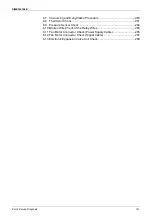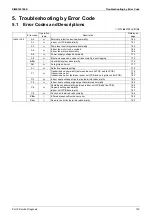
SiME332106E
Symptom-based Troubleshooting
Part 6 Service Diagnosis
145
6
COOL/HEAT
selection is
disabled.
The remote controller displays
the mark for centralized
control.
This remote controller has no option
to select cooling operation.
Use a remote controller with option
to select cooling operation.
The remote controller displays
the mark for centralized
control and the COOL/HEAT
selection remote controller is
provided.
COOL/HEAT selection is made
using the COOL/HEAT selection
remote controller.
Use the COOL/HEAT selection
remote controller to select cool or
heat.
7
The system
conducts fan
operation but not
cooling or
heating
operation.
This symptom occurs
immediately after turning ON
the power supply.
The system is in preparation mode
of operation.
Wait for a period of approximately
10 minutes.
The remote controller displays
the mark for centralized
control; no cooling or heating
operation is performed. Switch
to fan operation.
In thermal storage operation, the
unit is set to fan operation in cooling
or heating operation, and the
remote controller shows the mark
for centralized control.
Normal operation.
8
The airflow rate
is not reproduced
according to the
setting.
Even pressing the airflow rate
setting button makes no
changes to the airflow rate.
In heating operation, when the room
temperature reaches the set
degree, the outdoor unit will stop
while the indoor unit is brought to
fan LL operation so that no one gets
cold air.
Furthermore, if fan operation mode
is selected when other indoor unit is
in heating operation, the system will
be brought to fan LL operation.
Normal operation.
9
The airflow
direction is not
reproduced
according to the
setting.
The airflow direction is not
corresponding to that
displayed on the remote
controller.
The flap does not swing.
Automatic control
Normal operation.
10
A white mist
comes out from
the system.
Indoor unit
In cooling operation, the
ambient humidity is high.
(This indoor unit is installed in
a place with much oil or dust.)
Uneven temperature distribution
due to heavy stain of the inside of
the indoor unit
Clean the inside of the indoor unit.
Indoor unit
Immediately after cooling
operation stopping, the
ambient temperature and
humidity are low.
Hot gas (refrigerant) that has flowed
in the indoor unit results to be vapor
from the unit.
Normal operation.
Indoor and outdoor units
After the completion of defrost
control, the system is switched
to heating operation.
Defrosted moisture turns to be
vapor and comes out from the units.
Normal operation.
11
The system
produces
sounds.
Indoor unit
Immediately after turning ON
the power supply, indoor unit
produces ringing sounds.
These are operating sounds of the
electronic expansion valve of the
indoor unit.
Normal operation.
This sound becomes low after a
lapse of approximately one minute.
Indoor and outdoor units
Hissing sounds are
continuously produced while
in cooling or defrost control.
These sounds are produced from
gas (refrigerant) flowing
respectively through the indoor and
outdoor units.
Normal operation.
Indoor and outdoor units
Hissing sounds are produced
immediately after the startup
or stop of the system, or the
startup or stop of defrost
control.
These sounds are produced when
the gas (refrigerant) stops or
changes flowing.
Normal operation.
Indoor unit
Faint sounds are continuously
produced while in cooling
operation or after stopping the
operation.
These sounds are produced from
the drain discharge device in
operation.
Normal operation.
Indoor unit
Creaking sounds are
produced while in heating
operation or
after stopping the operation.
These sounds are produced from
resin parts expanding and
contracting with temperature
changes.
Normal operation.
Indoor unit
Sounds like trickling or the like
are produced from indoor
units in the stopped state.
On
VRV
systems, these sounds are
produced when other indoor units in
operation. The reason is that the
system runs in order to prevent oil
or refrigerant from dwelling.
Normal operation.
Outdoor unit
Pitch of operating sounds
changes.
The reason is that the compressor
changes the operating frequency.
Normal operation.
Symptom
Supposed Cause
Countermeasure
Содержание VRV RXYMQ-A Series
Страница 1: ...Service Manual RXYMQ A Series Heat Pump 50 60 Hz SiME332106E...
Страница 283: ...SiME332106E Check Part 6 Service Diagnosis 277 PCB and Circuit Diagram U V W L3B L2B L1B P1 P2 N32...
Страница 296: ...SiME332106E 290 Part 7 Appendix 1 Wiring Diagrams 291 1 1 Outdoor Unit 291 1 2 VRV Indoor Unit 293 Part 7 Appendix...
Страница 297: ...SiME332106E Wiring Diagrams Part 7 Appendix 291 1 Wiring Diagrams 1 1 Outdoor Unit RXYMQ4AVMK C 3D133942...
Страница 298: ...Wiring Diagrams SiME332106E 292 Part 7 Appendix RXYMQ4 5 6AYFK C 3D133944A...
Страница 303: ...SiME332106E Wiring Diagrams Part 7 Appendix 297 FXMQ40 50 63 80 100ARV1 3D127112 04 59...
















































